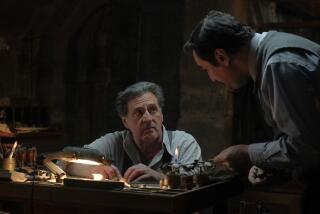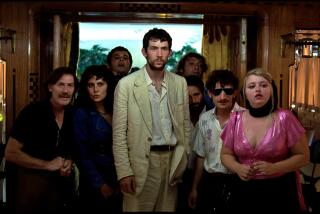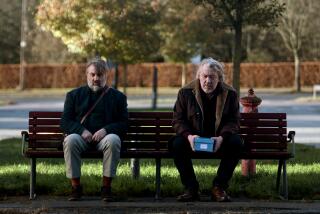Martin Scorsese goes kinder, gentler with ‘Hugo’
You think you know by now what you’ll get in a Martin Scorsese movie. Someone will be gothically whacked. A person’s tenuous grip on reality might slip away, possibly in a mental institution. Vengeance will be doled out — with guns, knives, fists or anything else that causes great bodily injury.
And a sweet orphan will search for a new family.
What looks at initial inspection like Hollywood’s version of a shotgun marriage — the man behind “Goodfellas,” “Raging Bull,” “The Departed,” “Shutter Island,” “Cape Fear” and “Gangs of New York” directs the 3-D family film “Hugo” — makes sense if you look closer. In some ways, Scorsese’s personal life and professional interests have guided him toward a gentle movie like this, even while audiences were cowering from his prior mayhem.
“It’s just natural this time,” says the director, who turned 69 on Thursday and is the parent, with book editor Helen Morris, of a 12-year-old daughter, Francesca, “in particular experiencing living life with not only parenting but a child being a partner with you and with your wife.
“There have been great films made about children, and some great films made from the point of view of children. But what does a child really understand or perceive?” Scorsese says, explaining what captivated him about the project.
Adapted by screenwriter John Logan (Scorsese’s “The Aviator”) from Brian Selznick’s popular, richly illustrated children’s book “The Invention of Hugo Cabret,” Scorsese’s new movie is a Dickensian drama about a lonely boy’s quest for happiness. The film also brings to life some of the Oscar-winning director’s longtime obsessions: the history of cinema and film preservation. “Hugo” simultaneously stands on its own as a drama while also being a love letter to the creation of the medium.
Like the novel, “Hugo,” opening Wednesday, is focused on the relationship between Hugo Cabret (Asa Butterfield), who tends to clocks in a 1930s Paris train station, and an ornery toy seller (Ben Kingsley). Hugo’s father (Jude Law) has long since died, and the drowning of Hugo’s alcoholic uncle (Ray Winstone) has left the young man fighting not only poverty and hunger but also a dictatorial station inspector (Sacha Baron Cohen), resolved to dispatch the urchin to an orphanage.
As he maintains the station’s massive timepieces, Hugo labors to fix a child-sized mechanical man, or automaton, that, once repaired, might be able to transcribe a message from the boy’s late father. The automaton carries other data in its wind-up memory, though, and those images at first threaten and then cement the relationship between Hugo and the toy seller, who turns out to be Georges Méliès, a pioneer in early cinema before his career, and many of his films, went up in flames. Selznick, who is distantly related to “Gone With the Wind” producer David O. Selznick, was inspired to write the book by seeing “A Trip to the Moon,” the famous 1902 Méliès short.
The very things that make “Hugo” attention-grabbing are also part of its commercial challenge. Cinéastes who are drawn to Scorsese’s mature movies might be reluctant to see a film about a 12-year-old boy. Parents, open-minded enough to take their kids to a Scorsese film, could see their younger children squirming when “Hugo,” which runs about two hours, delves into the history of motion picture production. And the film faces formidable weekend competition in the PG-rated realm from “The Muppets,” “Arthur Christmas” and the second weekend for “Happy Feet Two.”
But audiences of all ages should be more than a bit intrigued to see what one of American movies’ most celebrated directors can do with a family film, particularly with stereoscopic cameras. Like Méliès, who began his show business career as a magician, “Hugo” proves that Scorsese still has a few tricks up his sleeve.
Change of direction
When producer Graham King, who collaborated with Scorsese on “Gangs of New York,” “The Aviator” and the best picture-winning “The Departed,” was brought Selznick’s manuscript in 2007, he had a radical idea and sounded out the director. With abundant illustrations designed to mimic filmmaking storyboards, “The Invention of Hugo Cabret” felt like a gestating movie, King thought.
King also understood that Scorsese, having just laid waste to a busload of Boston police officers and mobsters in “The Departed,” was considering a change. “I knew Marty was looking to do something different — something with kids,” he said.
The director, who hadn’t made a PG-rated film since 1993’s “The Age of Innocence,” was chiefly interested in taking up “Shutter Island” at the time. Chris Wedge (“Ice Age”) at one point was announced as “Hugo’s” director, but production never commenced.
As time passed, Scorsese warmed to the idea, especially when a Logan draft landed as he was making 2010’s “Shutter Island.” After he finished that psychological thriller — but while he was busily working on his documentary “George Harrison: Living in the Material World” — Scorsese began figuring out how he could approach “Hugo.”
The director’s two daughters from two previous marriages were grown, but Francesca was a large presence in his daily life in Manhattan, and changed how he saw the world. “You begin to perceive everything around you differently, very differently,” he says, animating his conversation with bursts of laughter and hand gestures. “In a way, I’ve gone through it already a number of times, different times of my life, being a different person to a certain extent. And now, I said, ‘A lot of this is very interesting.’ I didn’t quite get it until I just had to deal with it, my wife and I.”
Like Hugo, Francesca created her own dream world, and Scorsese became a player in it. “She would begin to make imaginary rooms in her own room — I’m talking about a year and a half to 2 years old — where I found myself pretending to swim across the room. And I was enjoying it. ‘Swim here! I’m over here, it’s safe. Over here, be careful over here!,’ imagining what she’s imagining,” he says, in a bungalow of the Beverly Hills Hotel, where a loud party in a nearby villa prevented the director from sleeping much of the previous night.
Those experiences were the equivalent of an SAT prep class for the film, as Selznick’s book and Logan’s screenplay are also governed by Hugo’s perspective of the bustling, and potentially perilous, world around him.
“The threat of violence, a comic moment, the anthropomorphism of an animal’s face — all of this is an extraordinary, rich creative world,” Scorsese says. “To be free and to not be restricted by rules, in a way. There’s something about children and especially the creative ones — I’m watching a lot of these kids — it’s extraordinary freedom.
“The question in approaching ‘Hugo’ was in my mind if we’re going to perceive it through the boy’s eyes, [we needed to see] the isolation — that was the key that attracted me to the story: the isolation of the boy.”
Logan said one of the biggest challenges in adapting the novel was that even though the book was filled with movie-quality imagery, he had to convert Hugo’s internal thoughts into cinematic action. He added some secondary and composite characters to help populate the station. At the same time, he and Scorsese looked for ways to build up the story’s tension via the clockwork mechanisms.
Scorsese and King spared little expense (the producer says the film’s budget was less than $150 million). The director assembled a murderer’s row of Academy Award-winning department heads: production designer Dante Ferretti (“The Aviator,” “Sweeney Todd”), cinematographer Robert Richardson (“The Aviator,” “JFK”), editor Thelma Schoonmaker (“The Departed,” “Raging Bull”), costume designer Sandy Powell (“Shakespeare in Love,” “The Young Victoria”) and composer Howard Shore (“The Lord of the Rings,” “The Silence of the Lambs”).
After extensively researching 1930s Paris, the production team built a full-size train station inside England’s Shepperton Studios, in part to take advantage of the country’s tax credits and its proximity to some exteriors used in the film.
But how best to shoot “Hugo”? If a child has an exaggerated, hyper-real way of seeing, Scorsese wondered, how could he translate that point of view? What would bring moviegoers into Hugo’s universe and allow them to physically experience the bustle of his Parisian train station?
“It just seems so magical for me to create a heightened reality, a heightened world,” Scorsese says. “And not have audiences look at it from the outside.”
He had an idea how to get inside — 3-D.
In Méliès’ footsteps
Méliès, who died in 1938, was astonished when he saw an 1895 presentation from the Lumière brothers. “We sat with our mouths open,” he wrote of seeing one of the world’s first movies, “without speaking, filled with amazement.” Borrowing some techniques from his magic shows and inventing others, Méliès created and refined many filmmaking techniques still in use today — dissolves, time-lapse photography and special effects that allowed for transformations and substitutions.
Working a century later, Scorsese, who if he wasn’t behind a camera could be chairing the film studies department at a university, followed his French predecessor in using the newest tools and plunged into 3-D filmmaking.”Méliès was aiming that way anyway,” he explains. “There is some footage of his that’s in 3-D that’s been preserved in France right now.”
Still, today’s 3-D cameras are bulky and require complicated lighting. Scorsese was further restricted in how long he could work with his young actors — just four hours a day. And the director would occasionally complain that a shot wasn’t in focus — only to realize he was reviewing footage without his 3-D glasses on.
From the moment the film begins, you notice that Scorsese is using his stereoscopic cameras to give the film definable depth. The station is often filled with steam and smoke, escaping from heat vents, pipes, locomotives and even warm croissants, which helps to separate foreground from background. This makes the station’s hallways, passageways and galleries feel like a maze, with Hugo scurrying through it.
While he concedes the technology has been misused here and there — “over the years, there’s been some gimmicks” — he was certain it was the right choice after he saw James Cameron’s “Avatar.”
“I’ve collected 3-D pictures over the years. When I was a child, I had these postcards, I had two images on them, I could put them in a stereoscope and look at them. I’ll never forget Teddy Roosevelt and the Rough Riders and that sort of thing. And then when you see [‘Hugo’] in 3-D, the impression you feel is you’re there. You see around the person. You could feel the dust. And it transports you to another place.”
King says he realizes audiences will need some educating. “Telling parents that they can take their kids to a Scorsese movie — it’s a bit tough,” the producer says.
The director, who admits that he could show none of his recent movies to his youngest daughter, says to parents and children alike, Come on in. “Of any film that I could have made that would be considered a family film, I would make this, because of the boy,” says the director, who has yet to decide what his next project will be.
Logan says that no matter how operatic Scorsese’s films might be, they are connected by a common element. “Marty is at heart an absolute humanist,” Logan says. “What excites him beyond technical achievement is getting inside the souls of human beings. It could be ‘Taxi Driver’s’ Travis Bickle, and it could be Hugo Cabret. It’s what he does best.”
Times staff writer Emily Rome contributed to this report.
More to Read
The biggest entertainment stories
Get our big stories about Hollywood, film, television, music, arts, culture and more right in your inbox as soon as they publish.
You may occasionally receive promotional content from the Los Angeles Times.







